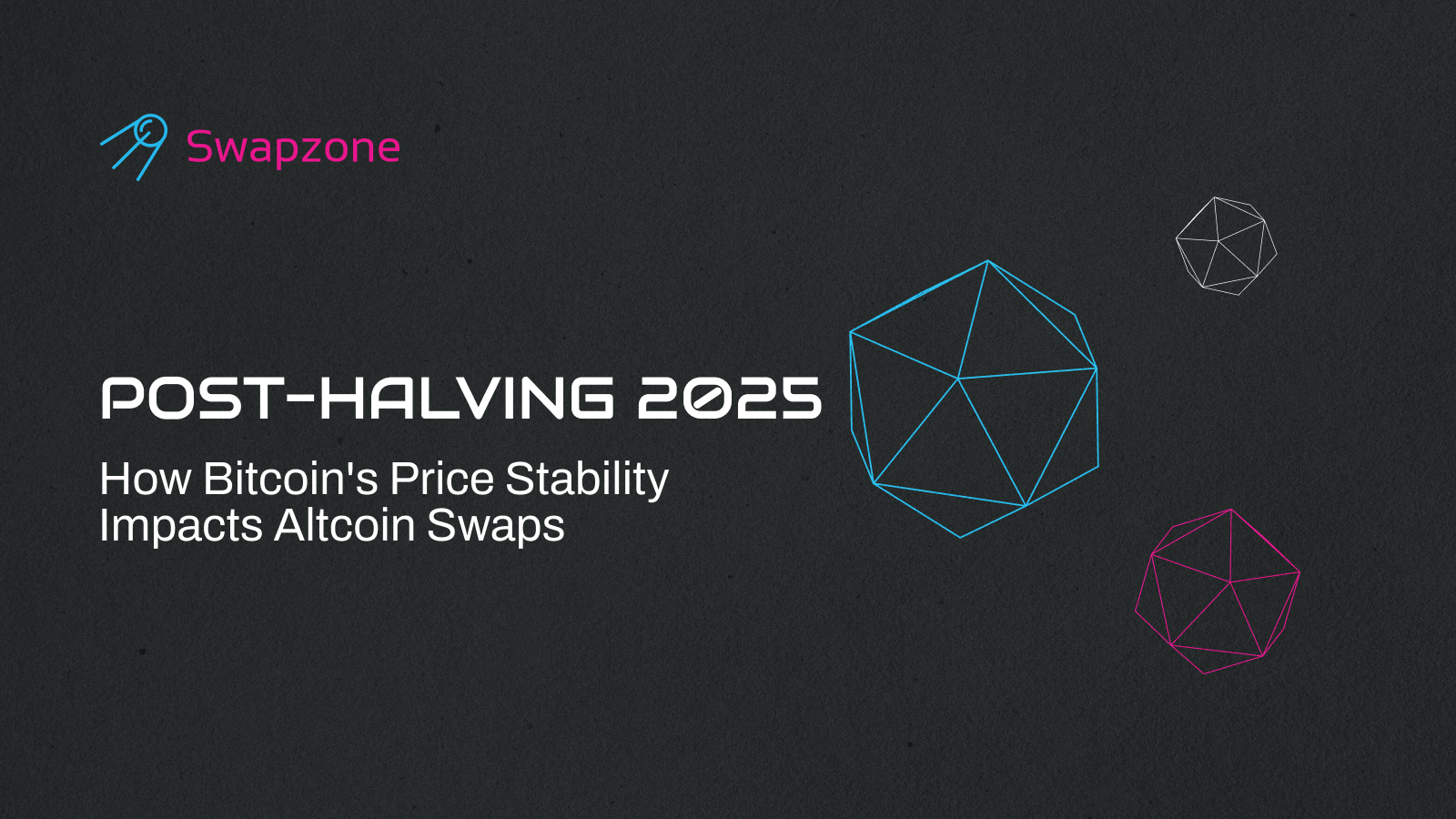Introduction
Every four years, the Bitcoin network undergoes a fundamental change: the block reward given to miners is halved. This event, known as the Bitcoin halving, is built into the cryptocurrency’s code to ensure a finite supply and combat inflation. In April 2025, Bitcoin completed its fourth halving, reducing the mining reward from 6.25 BTC to 3.125 BTC per block. While much of the conversation around halvings centers on Bitcoin’s price trajectory, the aftermath of this deflationary event sends ripples across the entire cryptocurrency ecosystem.
Historically, Bitcoin halvings have triggered sharp price rallies followed by heightened volatility. However, the focus in 2025 is shifting. Instead of asking whether Bitcoin will surge, analysts are watching to see if it stabilizes—and what that stability could mean for altcoins.
As altcoin swaps become increasingly integral to decentralized finance and portfolio diversification, Bitcoin’s behavior sets the tone for trading sentiment and asset allocation. This article explores how Bitcoin’s potential price stability in the post-halving period could influence the demand, volume, and structure of altcoin swaps.
Historical Context: Bitcoin After Halvings
The Halving Effect on Price Dynamics
Bitcoin has undergone three previous halving events—in November 2012, July 2016, and May 2020. Each has marked a turning point in market dynamics, followed by a characteristic pattern: an initial price rally, a period of intense volatility, and eventual market consolidation.
- 2012 Halving: Occurring when Bitcoin traded under $13, the first halving saw BTC rise to over $1,000 within a year. This dramatic price increase was driven by growing media coverage and investor awareness.
- 2016 Halving: Bitcoin rose from around $650 pre-halving to nearly $20,000 in late 2017. This bull run also marked the beginning of significant altcoin expansion, laying the groundwork for the ICO boom.
- 2020 Halving: BTC surged from around $9,000 to an all-time high of over $69,000 by late 2021. However, the subsequent bear market in 2022 brought significant corrections and exposed overleveraged positions across both centralized and decentralized platforms.
Volatility Patterns
In the aftermath of each halving, Bitcoin’s volatility typically spikes before entering a stabilization phase. The timeframes vary:
- Short-term (0–6 months post-halving): Increased speculation and momentum trading often drive price swings.
- Medium-term (6–18 months): As speculative fervor subsides, price action tends to stabilize around higher support levels.
- Long-term (18–36 months): Bitcoin often enters an accumulation phase, characterized by gradual upward movement or sideways trading.
If the post-2025 period follows historical precedent, we could expect a relative cooling-off phase where Bitcoin trades within a narrower range. This scenario would have significant implications for altcoins.
Why Bitcoin’s Stability Matters for Altcoins
Correlation and Market Sentiment
Bitcoin remains the market bellwether. Its movements shape trader sentiment and influence capital flow across the digital asset space. Historically, most altcoins exhibit a positive correlation with Bitcoin. When BTC rallies, altcoins often follow, although with varying magnitudes and time lags.
In periods of Bitcoin dominance—when BTC market share rises relative to altcoins—altcoins tend to underperform. Conversely, when Bitcoin stabilizes, capital often rotates into altcoins as investors seek higher returns or undervalued projects.
Reduced Volatility: A Catalyst for Altcoins?
When Bitcoin volatility decreases, altcoins often benefit in two key ways:
- Investor Reallocation: With Bitcoin perceived as a “safe” asset during periods of low volatility, risk-tolerant investors may shift focus to higher-beta altcoins in pursuit of alpha.
- Stable Trading Environment: Developers and long-term holders gain confidence to build and accumulate, leading to greater network activity and usage in altcoins with utility-driven demand.
Case Study: 2018–2019 and 2023 Mid-Cycle Periods
- After the 2017 bull run, Bitcoin entered a prolonged stabilization phase in 2018–2019. During this time, several altcoins (like Chainlink and Tezos) gained traction and decoupled to some extent from Bitcoin’s price trends.
- Similarly, in mid-2023, with Bitcoin trading between $25,000 and $30,000 for months, altcoin ecosystems—particularly those related to real-world assets, Layer 2 solutions, and DeFi—saw spikes in user engagement and swap volumes.
Impact on Altcoin Swaps
Shifts in Swap Demand
In a stable Bitcoin environment, altcoin swaps often see increased activity due to a few interrelated dynamics:
- Speculative Rotation: Traders may look to swap Bitcoin or stablecoins into altcoins with higher potential upside.
- Diversification Needs: Investors may seek to balance portfolios with a mix of mid- and low-cap assets, increasing swap transactions across a broader set of trading pairs.
- DeFi Utility: With less volatility, cross-chain swaps become more appealing for arbitrage, liquidity mining, and yield farming strategies.
Key Factors Affecting Swap Efficiency
- Liquidity: Stable markets enable deeper liquidity pools, particularly for mid-cap altcoins. This leads to narrower spreads and reduced slippage, encouraging more frequent swaps.
- Spread Sensitivity: Traders become more fee-sensitive during stable periods, prioritizing swap services or platforms that offer low spreads and high efficiency.
- Pair Popularity: Trading pairs involving stablecoins (e.g., USDC, USDT) and ETH often become more dominant than BTC-based pairs, especially when Bitcoin holds a flat trend.
Possible Scenarios
- Increased Swap Volume: If Bitcoin stabilizes, altcoin swap volumes may rise, especially for projects with strong narratives (e.g., AI, real-world assets, gaming).
- Changing Preferences: There may be a tilt toward utility-driven tokens and ecosystems with active developer communities, rather than meme coins or purely speculative assets.
- New Entrant Behavior: Retail users entering the market during post-halving stability may use swaps to explore altcoins as “cheaper” alternatives to Bitcoin.
Forecasts and Strategies for Traders
Altcoins Poised to Benefit
While speculative interest can drive short-term trends, the following categories may see increased swap interest in a stable BTC market:
- Layer 2 Solutions (e.g., Arbitrum, Optimism): Benefiting from scalability concerns and Ethereum’s fee dynamics.
- Utility and Governance Tokens (e.g., LINK, UNI): Tied to infrastructure and DeFi activity, these tokens often outperform during low-volatility periods.
- Real-World Asset (RWA) Protocols: Projects tokenizing physical assets like commodities or real estate may attract institutional attention amid macroeconomic uncertainty.
Strategic Considerations for Swaps
- Time Horizon: Traders with short-term goals should watch volume and momentum indicators to capitalize on emerging narratives.
- Liquidity Analysis: Evaluate DEX/CEX liquidity before executing large swaps to avoid excessive slippage.
- Cross-Chain Opportunities: Use interoperability tools to access altcoins on different blockchains efficiently, particularly as more networks adopt Layer 2 compatibility.
Risks and Opportunities
- Risk: A sudden macroeconomic event or regulatory action could reintroduce volatility, disrupting altcoin market stability and leading to capital flight back to Bitcoin or stablecoins.
- Opportunity: In the absence of large shocks, a stable BTC could provide a fertile environment for altcoin project growth, particularly those aligned with long-term technological trends.
Conclusion
Bitcoin’s post-halving behavior has consistently shaped the broader crypto market. If the 2025 halving leads to a period of relative stability for BTC, altcoins—and by extension, altcoin swaps—could enter a phase of growth and maturation.
Altcoin swaps may see increased volume, broader pair selection, and tighter spreads as traders rotate capital and explore diversified strategies. However, success will depend on the quality of altcoin projects, macroeconomic conditions, and evolving investor preferences.
As we move through the second half of 2025 and into 2026, crypto participants should closely monitor Bitcoin’s volatility metrics, altcoin correlation trends, and on-chain swap activity. Whether this post-halving era leads to a new altcoin season or a plateau in interest, informed trading strategies will be key to navigating the shifting landscape.


